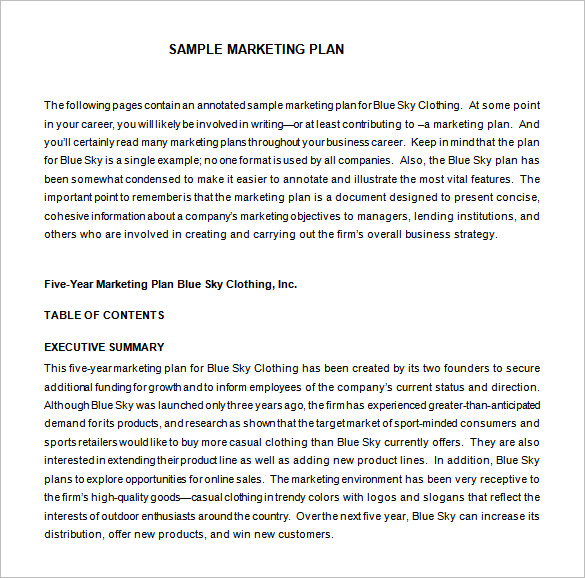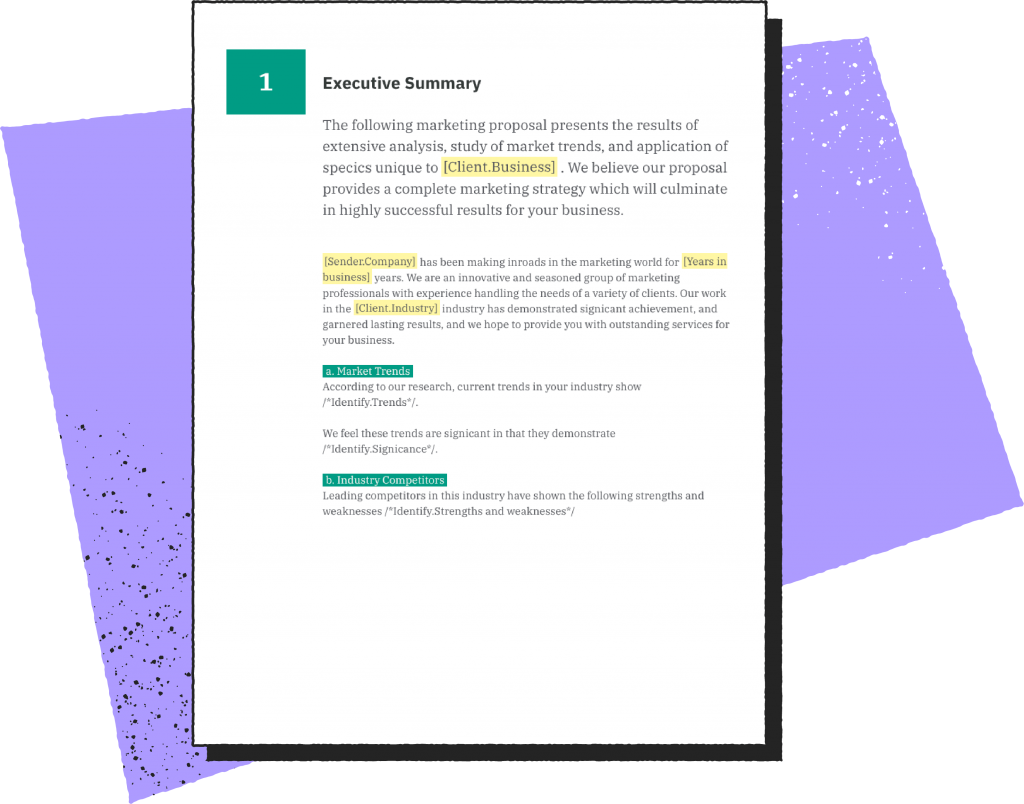A marketing proposal is a persuasive outline of your ideas and approach to meet a client’s marketing goals. An effective proposal aligns with the client’s business objectives and convinces them to hire you.
This comprehensive guide provides tips for crafting a compelling marketing proposal that wins new business
Marketing Proposal Purpose
A marketing proposal:
- Outlines your strategic plan to meet the client’s goals
- Details the costs, timelines, metrics, and benefits
- Sells the client on your experience and methodology
The proposal should function as a document the client can clearly understand and reference if they decide to work with you.
Marketing Proposal Components
While formats vary, most marketing proposals include:
Cover Letter: A brief introduction to your company and summary of the proposal.
Background: An overview of the prospect’s business, challenges, competition, and goals.
Objectives: The marketing objectives the proposal aims to accomplish.
Strategy: Your proposed strategy and tactics to achieve the objectives.
Budget and Timeline: Projected costs and completion timeframes.
Metrics: Success measurements and KPIs to track performance.
About Us: Your company credentials and case studies.
Terms and Conditions: Contract length, pricing, payment information.
Optional Sections: Testimonials, references, conclusions.
Now let’s explore how to write each section in a clear, compelling way.
How To Write a Marketing Proposal
Follow these steps when assembling your proposal:
1. Research the Client
Thoroughly investigate the prospect, their industry, competitors, and current marketing efforts. Understand their core challenges and goals. This enables you to tailor the proposal.
2. List a Scope of Work
Define the strategy, services, and tasks the proposal will cover, such as:
- Brand messaging development
- Search engine optimization
- Social media management
- Lead generation campaigns
Outline all major deliverables. This scopes the work for the client.
3. Provide Estimated Time Frames
Include a schedule estimating how long each stage will take to complete. This gives the prospect an idea of the project’s pace and key milestone dates.
4. Include Costs and Terms
Specify your fees with a detailed breakdown. Explain your pricing structure, payment options, and any retainers. Outline the proposed contract length and terms.
5. Show How You Plan to Measure Results
Describe the key performance metrics you’ll track, such as traffic, conversions, ROI, and engagement. Explain how you’ll monitor, analyze, and report on these KPIs.
6. Highlight Your Expertise
In the “About Us” section, spotlight your company’s credentials through case studies, client results, testimonials, awards, and team bios. Build confidence in your expertise.
After completing the key sections, polish the proposal to perfection. Verify that information flows logically and persuasively sells the client.
Marketing Proposal Template and Examples
Review proposal templates and samples to get presentation and format ideas. However, tailor your document so it speaks directly to the client’s needs vs. just copying a template.
6 Pro Tips for Creating Convincing Proposals
To craft an appealing, results-focused proposal:
-
Focus on the client’s goals and address their specific business challenges.
-
Avoid industry jargon and use clear, concise language the client will understand.
-
Emphasize ROI and back it up with metrics, projections, and proven results.
-
Keep brand consistency with colors, fonts, and tone aligned to your company’s image.
-
Make it skimmable with an executive summary, headings, bullet points, and highlights.
-
Use visuals like charts to make data easily digestible.
A polished proposal both informs and persuades the prospect to buy into your solution.
How to Follow Up on Your Proposal
Don’t disappear after submitting the proposal. To boost your odds of winning the business:
-
Send a confirmation email to ensure they received it.
-
Call or email after a few days to answer any additional questions.
-
Offer to schedule a call to walk through the proposal in more depth.
-
Ask if they require any clarification or have concerns to address.
-
Request a timeline for their decision if one wasn’t provided.
-
Periodically follow up if you haven’t heard back.
Proactively communicating with the prospect after submitting your proposal will strengthen your bid.
Key Takeaways
-
A marketing proposal outlines your strategy and approach to achieve the client’s marketing objectives.
-
Research the client thoroughly so you can tailor the proposal to their specific goals.
-
Clearly explain your planned costs, timelines, actions, metrics, and projected ROI.
-
Highlight your expertise through case studies and credentials to build confidence.
-
Use a persuasive writing style focused on their business needs and ROI.
With a compelling, client-centered proposal that sells your solution, you’ll be primed for new marketing business and victories.

Step 4: Write the marketing proposal
With all of these elements together, you can write the proposal.
Your marketing proposal will have several distinct parts:
- Cover page
- Executive summary (introduction)
- Action plan (methodology)
- Timeline
- Research and brainstorming
- Pricing
- Conclusion and next steps
It might seem superfluous or unnecessary, but a good cover page is the first thing your potential client will see.
Even in our digital age, proposals are printed out or hard copies may be requested, so a good cover page or title page is a must.
The cover page should have your company’s name and contact information, the client’s name and contact information, and the preparer.
PandaDoc’s proposal templates have cover pages to suit every need, with customizable options to fit your business design.

Also called the introduction, the executive summary is a brief overview of who your company is, what your proposal offers, and why this proposal should be accepted by the client.
Although the executive summary is the first thing your client will read (and possibly the only thing), you should write it last, after the rest of the proposal has been completed.
The executive summary should be a balance between a general overview of the goals of the project and the research you’ve based your project on, without being too broad and nonspecific.
The executive summary should provide the reader with a good idea of what the project is going to accomplish without getting bogged down in technical details.
If your proposal is delivered in electronic format, the executive summary can include links to your company website or other documentation.
If the proposal is meant to be printed or will be both electronic and printed, your internal links should also include footnotes or a bibliography with links for the readers to access later.
The action plan is the meat of your proposal. In this section, which may include multiple subsections, you will lay out the plan that you devised from your analysis and discussions with the client during the research phase.
A possible plan might look like this:
Part one: State the issue you will be focusing on. Using the information from your research, describe the problem specifically and how your proposal will address it.
For example: “We found that your Facebook advertising is missing about one-third of your target market,” or “We intend to re-optimize your SEO (search engine optimization) so that your advertising falls back in line with your intended audience.”
Part two: Give a timeline for both managing the issue and assessing your solution.
For example: “We have allotted four weeks for the optimization and will assess the effectiveness in three months, six months, and nine months to allow for the time it takes for the change to show up in Facebook’s algorithms.”
Part three: Explain how any issues that might arise will be handled and what follow-up the client can expect.
For example: “If it appears in three months that the desired effect is not beginning to appear, our SEO experts will reassess your advertising to see if the ads need to be reworded.”
Part four: Describe how your pricing is managed.
For example: “The optimization is done on a contract basis per project, and the monitoring of your advertising is done in-house on an hourly basis.”
This would be repeated for each step of the proposed project. Small projects or proposals would naturally have shorter action plans, whereas large projects or clients might have multiple plans with many subsections.
One caveat: The proposal should not be so complicated that it is impossible to read. If the project is so large that it requires multiple action plans, it would be best to write a separate proposal for each section.
Each part of the action plan will have a short timeline of its own, but the entire project should have a timeline from start to finish, and this timeline will have its own section in your proposal.
Deadlines are an important part of any contract. If any of the deadlines in your proposal are not feasible for you or the client, it is best to know about it during the proposal process, and not after the final contract has been signed.
Surprisingly, many proposals fail to include a timeline, either because the writer didn’t think it was important or believed that it would be included in the contract.
A timeline in your proposal shows that your team has already thought about how and when the important parts of the project are due and what both you and the client can expect.
The timeline gives both you and the client a visual representation of the project and what benchmarks to expect going forward.
What should be included in your marketing proposal?
No matter the type of proposal you are writing, it should always contain the following information:
- Your company information. This is data about who you are, why you are uniquely qualified for this job, and why the client should pick you over any other agency. Your company information can be kept in a separate file because it will be mostly the same for each proposal. Your team should have standard bios and headshots ready to go for each project.
- Knowledge of the issues. This will summarize the data you obtained in your research and discussion sessions. For example, if your client is launching a new product and is looking for a digital marketing strategy, you might want to bring search data, estimated advertising costs for winning keywords, and examples of previous launch campaigns you’ve done that illustrate your success.
- Methodology and pricing. This is what you are going to do and how much it will cost. Methodology and pricing usually have their own section, near the end of your proposal.
- Initial action plan. The action plan in the proposal may be your final offer or not, as discussed below.
How to Create a Marketing Plan | Step-by-Step Guide
What should a marketing proposal include?
As with many business documents, marketing proposals will contain a standardized set of information about your business, along with the goods and services that you provide. After your research is complete, you’ll need to customize your service offering to align with your customer’s business needs.
How to write an effective marketing proposal?
Follow these steps to write an effective marketing proposal: 1. Conduct research on your client To keep the client’s attention throughout the entire proposal, you should cater directly to them. Conduct extensive research on your client’s business, market and competition. Use this research to uncover any challenges they could face in their industry.
How do I write a marketing proposal for my clients?
Follow these tips to write a strong, compelling and persuasive marketing proposal for your clients: Though a portion of your proposal should focus on the results and achievements you’ve brought in for past clients, its main content should focus more on the current client, rather than you and your company.
How to write a persuasive marketing proposal?
Follow these steps to write a persuasive marketing proposal that impresses your prospective clients. 1. Design a Polished and Visually Appealing Cover Page Your cover page is the window to the rest of your proposal. So you should aim to make an excellent first impression. Your proposal cover page design should have a clean and bold aesthetic.